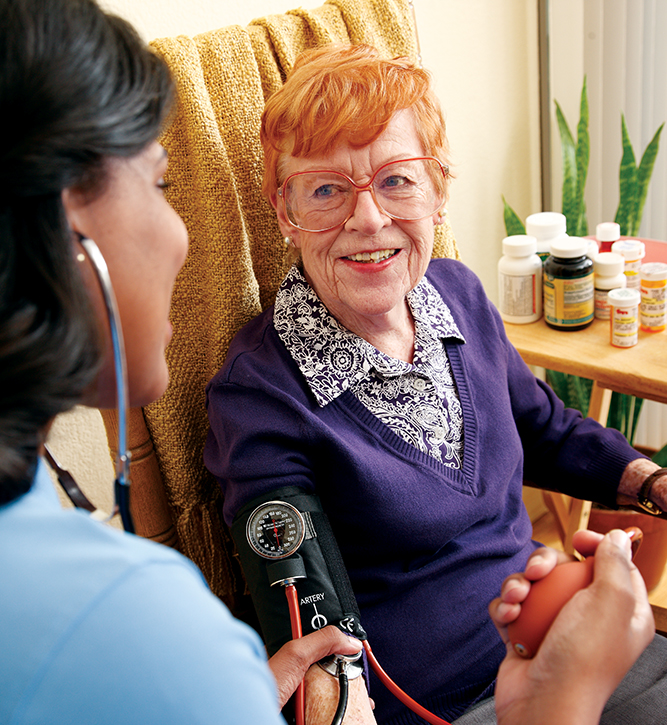Children’s Health Insurance Program (CHIP)
Children’s Health Insurance Program (CHIP) is an all-encompassing benefit program for nearly 6.7 million uninsured children nationwide. Eligibility for the program is most often determined financially and is federally required to provide primary care, dental care, behavioral health services and vaccinations for children from birth to age 19.1
Community-Based Organization (CBO)
Community-based organizations (CBOs) are typically nonprofit organizations that work to improve the health and quality of life in the community they represent. CBOs often work beyond the typical parameters of the health care sector by providing housing, healthy food options, outreach programs and more to the members of their community.2
Federal Poverty Level (FPL)
The federal poverty level (FPL) is an annual assessment of an individual’s total yearly income to determine social service coverage and other benefits, such as Medicaid or CHIP eligibility. The FPL can increase or decrease on a year-to-year basis, and eligibility depends on family size as well as total income, with an FPL that grows as an individual’s family size grows.3
Federally Qualified Health Center (FQHC)
Federally Qualified Health Centers (FQHCs) are community-based entities that provide comprehensive care to local, often underserved individuals, regardless of coverage. FQHC offerings include primary and preventive health services, as well as dental, specialty and emergency care. They serve Medicaid members, individuals facing homelessness, migrants and other populations, regardless of their ability to pay for care.4
Fee-for-Service (FFS) Delivery System
Different from the fee-for-service (FFS) payment model, a Fee-for-Service Delivery System is a program model issued by states without a managed care organization (MCO) to deliver care. In an FFS Delivery System, the state serves the “payer” role, directly paying service providers for care and services offered to their members.5
Fee-for-Service (FFS) Payment Model
The “standard” payment model for most insurance providers and payers, a fee-for-service (FFS) model reimbursement or direct payer payment follows care delivery. Each visit to a health professional under an FFS payment model is billed separately. Unlike a value-based payment (VBP), FFS is not dependent on the health outcome of the visit.6
Home-and Community-Based Services (HCBS)
Home- and Community-Based Services (HCBS) provide care for Medicaid beneficiaries in their own home or community (e.g., hospice), rather than institutions or other facility-based settings. HCBS programs help a variety of targeted population groups, such as people with intellectual or developmental disabilities, physical disabilities and/or mental illnesses. Examples of HCBS include home-delivered meals, transportation, home repairs and modifications, and financial services.7
Long-Term Services and Supports (LTSS)
Coordinated across providers and settings, long-term services and supports (LTSS) include a range of services that assist individuals with functional limitations on their ability to carry out daily activities. Among the millions of children, adults and seniors making use of LTSS in the United States, Medicaid is the leading payer.8
Medicaid Managed Care (MMC)
Focused on managing cost, utilization, and quality, Medicaid Managed Care (MMC) enables benefit delivery and related services through contracts between state-level Medicaid agencies and managed care organizations (MCOs). These arrangements leverage an established rate of payment for those services based on a set number of members receiving care in a month.9
Social Determinants of Health (SDOH)
Social determinants of health (SDOH) are the economic and social conditions that influence health status. Broadly defined by the World Health Organization as “the conditions in which people are born, grow, live, work and age,” key social determinants of health include employment, housing and access to transportation. Social determinants are studied and addressed at the individual, community and population level.10
Temporary Assistance for Needy Families (TANF)
Temporary Assistance for Needy Families (TANF) is a federal program designed to help needy families become self-sufficient. States receive block grants to design and administer the time-sensitive program to help ensure that dependent individuals are cared for while still being able to be part of their family.11
Value-Based Care (VBC)
Value-based care (VBC) programs offer monetary incentives to health care providers for the quality of care they deliver to people. Value-based care programs are designed to focus on better care for individuals, better health for populations and lowering costs.12
Maternal health outcomes in the United States have reached crisis levels compared with the rest of the world, and they’re getting worse. Preterm birth rates have increased in the U.S. for the past 5 years, and the number of birthing people who experience Severe Maternal Morbidity (SMM) has also continued to grow. These poor outcomes, however, impact some more than others. Black birthing people experience preterm birth rates that are 49% higher than for all other birthing people, and they are 3 to 4 times more likely to die from childbirth than White birthing people.
Read the full glossary
These acronyms are a small selection of terms available in the UnitedHealthcare Community & State Medicaid Glossary. Read more at uhccs.com/Medicaid-glossary.
Sources
- https://www.medicaid.gov/chip/chip-managed-care/index.html Opens in a new window
- https://www.universalclass.com/articles/business/impact-of-community-based-organizations.htm Opens in a new window
- https://www.healthcare.gov/glossary/federal-poverty-level-fpl/ Opens in a new window
- https://www.cms.gov/Outreach-and-Education/Medicare-Learning-Network-MLN/MLNProducts/Downloads/fqhcfactsheet.pdf Opens in a new window
- https://www.macpac.gov/medicaid-101/provider-payment-and-delivery-systems/ Opens in a new window
- https://www.macpac.gov/medicaid-101/provider-payment-and-delivery-systems/ Opens in a new window
- https://www.medicaid.gov/medicaid/home-community-based-services/index.html Opens in a new window
- https://www.uhccommunityandstate.com/articles/a-framework-for-success-for-mltss.html Opens in a new window
- https://www.medicaid.gov/medicaid/managed-care/index.html Opens in a new window
- https://www.who.int/teams/social-determinants-of-health Opens in a new window
- https://www.acf.hhs.gov/ofa/programs/tanf/about Opens in a new window
- https://www.cms.gov/Medicare/Quality-Initiatives-Patient-Assessment-Instruments/Value-Based-Programs/Value-Based-Programs Opens in a new window
This glossary is intended to be informational only and relates to terms used commonly in Medicaid programs and design. In most cases, terms are derived from publicly available sources. Terms covered in this glossary are subject to change and may have alternate definitions when used in relation to other programs or products, or by other sources or companies.

